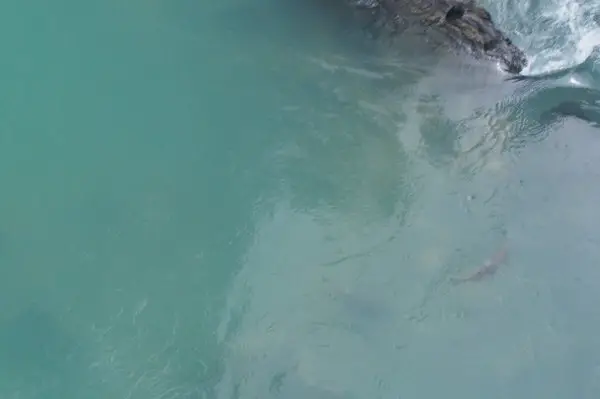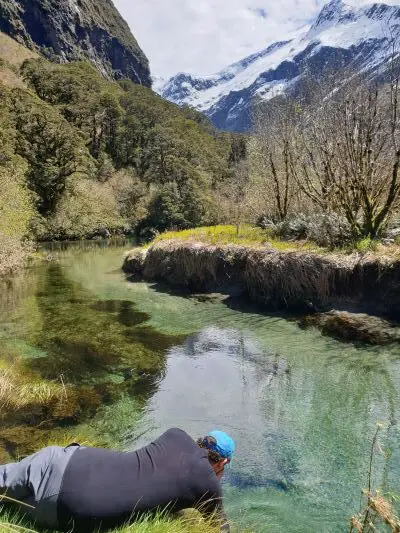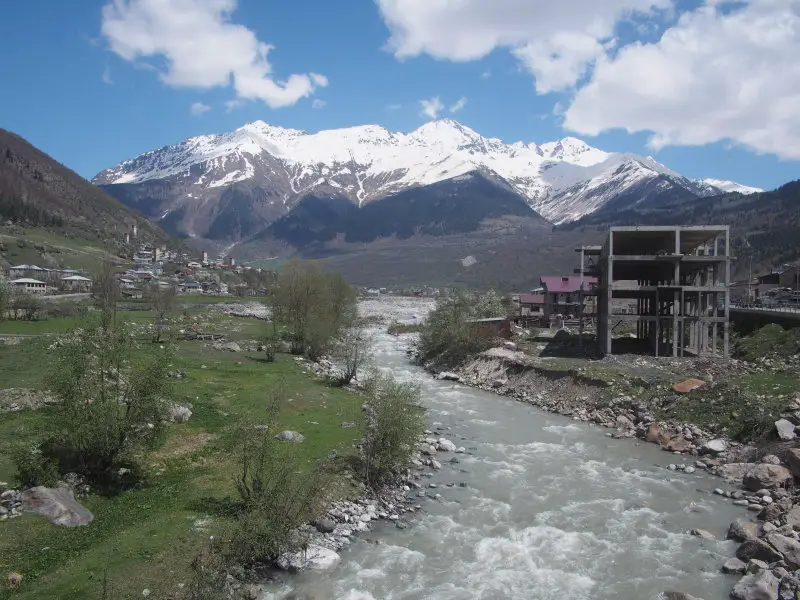The spring thaw is often associated with Warm days and roaring streams. Spring can be a difficult time to trout fish in the mountains. But it is also a time full of opportunities.
When fishing during the thaw. I like to fish deep, and fish slow. That is because the trout tend to hold towards the bottom, and due to the lower water temperatures they are quite lethargic.
At the peak of the thaw, when a stream is roaring bank to bank with snowmelt. Chances are the fishing will be difficult. The water temperature is simply too cold for the trout to feel like feeding.
It might seem strange, but warmer air temperatures can actually result in colder water temperatures because it accelerates the rate at which the snow melts.
Your exact experiences will differ depending on exactly where you fish, many of my local rivers run high with melting snow and ice for several months, but lower down in the valleys the snowmelt gets diluted and quality fishing can be had.

Can you catch trout in snow melt?
Yes trout can be caught in snowmelt, but it does largely depend on the water temperature. The colder the water the less the trout feed. If the water temperature is close to freezing, fishing is going to be very difficult and the trout will be extremely unlikely to chase after a moving meal. Present the food to them, do not expect them to chase after it.
During the peak of the thaw, the small mountain springs are often too cold and violent to fish. But quality fishing can still be had further downstream. The larger rivers often seem to be a few degrees warmer. Probably due to the snowmelt mixing with raising groundwater which is usually well over 40 degrees.
These larger rivers still need to be clear enough to be worth fishing. Wearing waders, I like to wade into knee deep water. If I can see my boots, then the river is clear enough and I start fishing.
Some of these large rivers can flow milky with snow and glacier melt well into the summer months. They often prove to be ideal habitat for trout. Several world record trout, have been caught from the snow and glacier feed Tekapo canals in New Zealand. The few time I visited, they still contained glacier flour well into the summer months. If there is enough food, trout thrive in very cold water.
Start of the melt can be amazing fishing
The first day or two of the thaw can have excellent trout fishing. As the snow melts, river levels start to rise rapidly. Aquatic and even some terrestrial insect life gets washed downstream. Maybe the trout are aware of what is about to happen, or maybe it is just opportunistic feeding but at this time trout will start to gorge themselves, hungrily snatching at any food drifting by.
Take the temperature, if the water is too cold, the fishing slows
As the melt intensifies, and streams turn into torrents, the water temperature drops rapidly. Snowmelt is barely above freezing, which quickly cools any residue flow. While it is possible to catch trout in water temperatures as low as 34 degrees it becomes increasingly difficult.
I suggest taking the temperature. If the water temperature is below 40 degrees it usually will be more productive to head somewhere warmer to fish.
Where to fish during the thaw?
Finding trout in snowmelt can be difficult, spotting is nearly impossible through the milky water. Plus they are unlikely to be raising to the surface. Most trout will be holding close to the bottom, usually in deeper pools and slow runs.
It is always a good idea to scout, and find the trout before the thaw begins. This will save a lot of time blind fishing trying to find their holding locations.
If you are fly fishing use streamers
At this time of year, trout are hungry. They have spawned, then survived the frigid winter months. What they need is a lot of calories to try and recover their condition. While they are unlikely to be fussy, they can be very sluggish and not prepared to give chase. Presenting the streamer right into their feeding zone is of the most importance.
I like to fish, heavily weighted, beadhead streamers. I try to bounce them along the bottom through deeper looking water. I retreive as slowly as possible while maintaining contact with the fly. Everything slows down when it is cold.
It is also possible to fish nymphs, but again I use a heavy tungsten nymph to get them down deep and I fish them beneath a highly buoyant strike indicator. The exact pattern is not usually that important, you just need to be able to drift it directly to the waiting the feeding trout. It is all about presentation and accuracy.
If you are spinning use spoons
When spinning, I personally reach for my tackle box containing spoons. (Check out my spoon recommendations here) . I like to cast upstream and allow them to flutter downstream bouncing across the bottom. Get them down deep because the trout are often holding right on the bottom.
If you are not getting the occasional snag you are not fishing deep enough. I can not explain why, but plain white spoons seem to work when the water is cloudy with snowmelt.
If you do not own any spoons, or struggle with the bottom bouncing techniques. A quick sinking inline spinner, such as a Panther Martin or Blue Fox Vibrax can also be effective if fished near the bottom. If you want to learn more about effective ways to fish different inline spinners I have a guide here.
Tailwaters can stay warmer
Sometimes the rivers are simply running too high and too cold. Luckily there are still a few places worth fishing, one of the most productive fishing locations can be tailwaters. Large lakes and reservoirs do a great job at regulating the water temperature. So while the streams feeding into them might be white with snow melt, the water flowing out is usually several degrees warmer.

Spring creeks can stay warmer
Spring creeks like the names suggest get the majority of their water from springs. Ground water, in the early spring and winter, is usually several degrees warmer than surface flows.
The river nearest my house, can get down to around 40f in early spring and the trout become a bit sluggish, but the nearby spring creek rarely drops below 60f. It provides great fishing when the other waters are still too cold for the trout to be active.
Conclusion
The spring melt can be a challenging, but also rewarding time to fish. Some of the best trout fishing can be had right at the start of the melt. That initial surge of new water can trigger trout into feeding.
At the peak of the thaw, streams typically run too fast and cold for trout fishing. At this time, it is usually better to head further downstream and hope to find areas where the snow melt is more diluted.

